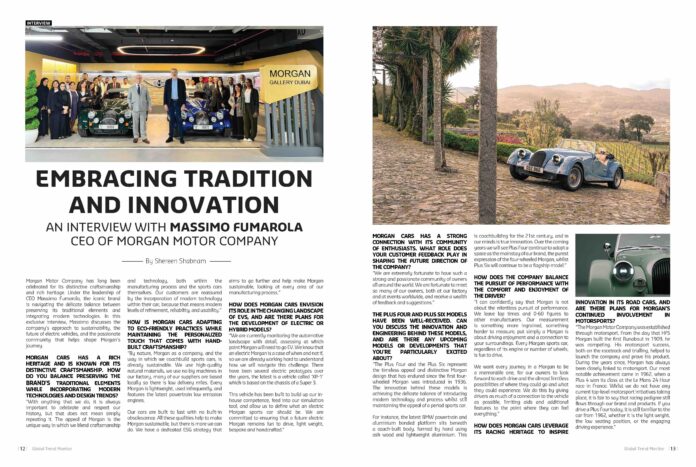An Interview with Massimo Fumarola, CEO of Morgan Motor Company
Shereen Shabnam
Morgan Motor Company has long been celebrated for its distinctive craftsmanship and rich heritage. Under the leadership of CEO Massimo Fumarola, the iconic brand is navigating the delicate balance between preserving its traditional elements and integrating modern technologies. In this exclusive interview, Massimo discusses the company’s approach to sustainability, the future of electric vehicles, and the passionate community that helps shape Morgan’s journey.
Morgan Cars has a rich heritage and is known for its distinctive craftsmanship. How do you balance preserving the brand’s traditional elements while incorporating modern technologies and design trends?
“With anything that we do, it is always important to celebrate and respect our history, but that does not mean simply repeating it. The appeal of Morgan is the unique way in which we blend craftsmanship and technology, both within the manufacturing process and the sports cars themselves. Our customers are reassured by the incorporation of modern technology within their car, because that means modern levels of refinement, reliability, and usability.”
How is Morgan Cars adapting to eco-friendly practices while maintaining the personalized touch that comes with hand-built craftsmanship?
“By nature, Morgan as a company, and the way in which we coachbuild sports cars, is already sustainable. We use high-quality natural materials, we use no big machines in our factory, many of our suppliers are based locally so there is low delivery miles. Every Morgan is lightweight, used infrequently, and features the latest powertrain low emission engines. Our cars are built to last with no built-in obsolescence. All these qualities help to make Morgan sustainable, but there is more we can do. We have a dedicated ESG strategy that aims to go further and help make Morgan sustainable, looking at every area of our manufacturing process.”
How does Morgan Cars envision its role in the changing landscape of EVs, and are there plans for the development of electric or hybrid models?
“We are currently monitoring the automotive landscape with detail, assessing at which point Morgan will need to go EV. We know that an electric Morgan is a case of when and not if, so we are already working hard to understand how we will navigate this challenge. There have been several electric prototypes over the years, the latest is a vehicle called ‘XP-1’ which is based on the chassis of a Super 3. This vehicle has been built to build up our in-house competence, feed into our simulation tool, and allow us to define what an electric Morgan sports car should be. We are committed to ensuring that a future electric Morgan remains fun to drive, light weight, bespoke and handcrafted.”
Morgan Cars has a strong connection with its community of enthusiasts. What role does your customer feedback play in shaping the future direction of the company?
“We are extremely fortunate to have such a strong and passionate community of owners all around the world. We are fortunate to meet so many of our owners, both at our factory and at events worldwide, and receive a wealth of feedback and suggestions.”
The Plus Four and Plus Six models have been well-received. Can you discuss the innovation and engineering behind these models, and are there any upcoming models or developments that you’re particularly excited about?
“The Plus Four and the Plus Six represent the timeless appeal and distinctive Morgan design that has endured since the first four-wheeled Morgan was introduced in 1936. The innovation behind these models is achieving the delicate balance of introducing modern technology and process whilst still maintaining the appeal of a period sports car. For instance, the latest BMW powertrain and aluminium bonded platform sits beneath a coach-built body, formed by hand using ash wood and lightweight aluminium. This is coachbuilding for the 21st century, and in our minds is true innovation. Over the coming years we will see Plus Four continue to adopt a space as the mainstay of our brand, the purest expression of the four-wheeled Morgan, whilst Plus Six will continue to be a flagship model.”
How does the company balance the pursuit of performance with the comfort and enjoyment of the driver?
“I can confidently say that Morgan is not about the relentless pursuit of performance. We leave lap times and 0-60 figures to other manufacturers. Our measurement is something more ingrained, something harder to measure, put simply a Morgan is about driving enjoyment and a connection to your surroundings. Every Morgan sports car, regardless of its engine or number of wheels, is fun to drive. We want every journey in a Morgan to be a memorable one, for our owners to look forward to each drive and the almost limitless possibilities of where they could go and what they could experience. We do this by giving drivers as much of a connection to the vehicle as possible, limiting aids and additional features to the point where they can feel everything.”
How does Morgan Cars leverage its racing heritage to inspire innovation in its road cars, and are there plans for Morgan’s continued involvement in motorsports?
“The Morgan Motor Company was established through motorsport. From the day that HFS Morgan built the first Runabout in 1909, he was competing. His motorsport success, both on the racetrack and trialling, helped to launch the company and prove his product. During the years since, Morgan has always been closely linked to motorsport. Our most notable achievement came in 1962, when a Plus 4 won its class at the Le Mans 24 Hour race in France. Whilst we do not have any current top-level motorsport initiatives taking place, it is fair to say that racing pedigree still flows through our brand and products. If you drive a Plus Four today, it is still familiar to the car from 1962, whether it is the light weight, the low seating position, or the engaging driving experience.”
